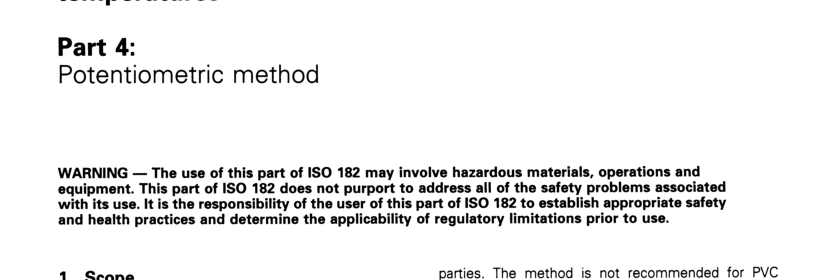BS EN ISO 182-4:2001 – Plastics Ð Determination of the tendency of compounds and products based on vinyl chloride homopolymers and copolymers to evolve hydrogen chloride and any other acidic products at elevated temperatures Ð Part 4: Potentiometric method

1 Scope
1.1 This part of ISO 182 specifies a method for the determination of the thermal stability at elevated temperature of compounds and products based on vinyl chloride homopolymers and copolymers (in the following text abbreviated as PVC) which undergo dehydrochlorination (the evolution of hydrogen chloride).
1.2 The method may be used as a quality control test during manufacture and conversion of PVC com- pounds. It may also be used for the characterization of PVC compounds and products, especially with regard to the effectiveness of their heat-stabilizing sys- tems. It is suitable for coloured PVC compounds and products for which a discolouration test under the action of heat may be unsatisfactory.
1.3 The method is recommended for compounded PVC materials and products only, although it can be used for polymers in powder form under appropriate conditions to be agreed upon between the interested parties. The method is not recommended for PVC compounds in the form of dry blends, since such materials may not be sufficiently homogeneous.
1.4 PVC compounds and products may evolve other decomposition products in addition to hydrogen chloride at elevated temperatures. A limited number of these products, originating from the decomposition of certain comonomers (such as vinyl esters of organic acids) or of plasticizers, stabilizers and other additives, may effect the pH or the conductivity of an aqueous solution when they are absorbed. Conse- quently, the results obtained for different products by the methods described in Parts 2 and 3 of ISO 182 may not be comparable with those obtained using the method described in the present part of ISO 182.
1.5 This part of ISO 182 specifies a potentiometric method for the determination of chloride ion (CI ) concentration (expressed as pCI) in an absorbing solution, independent of the presence of other ions. The value pCI is defined aslg CI where Cl is the molar concentration of chloride ions. This method is, therefore, particularly recommended for plasticized PVC compounds and copolymers.
1.6 This method may also be applied to other plas- tics materials that can evolve hydrogen chloride when heated under the conditions prescribed by the relevant specifications, or as agreed upon between the interested parties.
2 Normative references
The following standards contain provisions which, through reference in this text, constitute provisions of this part of ISO 182. At the time of publication, the editions indicated were valid. All standards are subject to revision, and parties to agreements based on this part of ISO 182 are encouraged to investigate the possibility of applying the most recent editions of the standards indicated below. Members of IEC and ISO maintain registers of currently valid International Standards.
ISO 182-2:1990,Plastics – Determination of the tendency of compounds and products based on vinyl chloride homopolymers and copolymers to evolve hydrogen chloride and any other acidic products at e/evated temperatures – Part 2: pH method. ISO 182-3:1993,Plastics – Determination of the tendency of compounds and products based on viny/ chloride homopolymers and copolymers to evolve hiydrogen chloride and any other acidic products at外 evated temperatures 一Part 3: Conductometric method.
BS EN ISO 182-4:2001 – Plastics Ð Determination of the tendency of compounds and products based on vinyl chloride homopolymers and copolymers to evolve hydrogen chloride and any other acidic products at elevated temperatures Ð Part 4: Potentiometric method